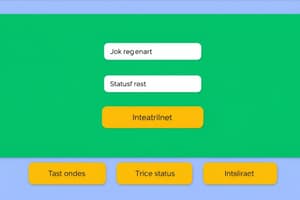Podcast
Questions and Answers
What is the primary purpose of work order priorities?
What is the primary purpose of work order priorities?
- To list all completed tasks for future reference
- To designate the importance of tasks that need immediate attention (correct)
- To categorize tasks based on their completion status
- To track the overall progress of multiple tasks
Which status indicates that a work order is currently unable to be completed immediately?
Which status indicates that a work order is currently unable to be completed immediately?
- Completed
- In progress
- Paused
- Awaiting parts (correct)
Which of the following is NOT an example of an exception in work order management?
Which of the following is NOT an example of an exception in work order management?
- The maintenance tech has completed their tasks (correct)
- A required part for completion is missing
- The resident is not home during the service visit
- The task has to be postponed due to unforeseen circumstances
What type of situation might lead to a work order being marked as an exception?
What type of situation might lead to a work order being marked as an exception?
How should work orders that are not urgent be classified?
How should work orders that are not urgent be classified?
What question does the status of a work order typically help answer?
What question does the status of a work order typically help answer?
Why is it important to differentiate work order priorities from dashboard priorities?
Why is it important to differentiate work order priorities from dashboard priorities?
What scenario could likely cause a work order to have an 'awaiting parts' status?
What scenario could likely cause a work order to have an 'awaiting parts' status?
Flashcards are hidden until you start studying
Study Notes
Work Orders Overview
- Work orders are categorized by three key factors: priorities, statuses, and exceptions.
- These elements help in managing maintenance tasks efficiently.
Priorities
- Priorities rank the importance of tasks, ensuring critical issues are addressed first.
- Example: A flooded apartment is prioritized over changing a light bulb.
- Work order priorities are not the same as Maintenance Dashboard priorities, which only appear on the Entrata Dashboard.
Statuses
- Statuses provide insights into the progress of work orders.
- Questions addressed by statuses include whether the order is new, if it’s been addressed, and if the maintenance tech has what they need to proceed.
- Work orders can be in various statuses as they move toward completion.
Exceptions
- Exceptions are situations where a work order cannot be completed in one visit and might require follow-up.
- They track reasons for delays, ensuring all team members are informed about unresolved work.
- Example: A work order for a light post may be paused due to waiting for a special bulb that isn't available.
- Exceptions ensure clear communication on the challenges faced in completing maintenance tasks.
Studying That Suits You
Use AI to generate personalized quizzes and flashcards to suit your learning preferences.



